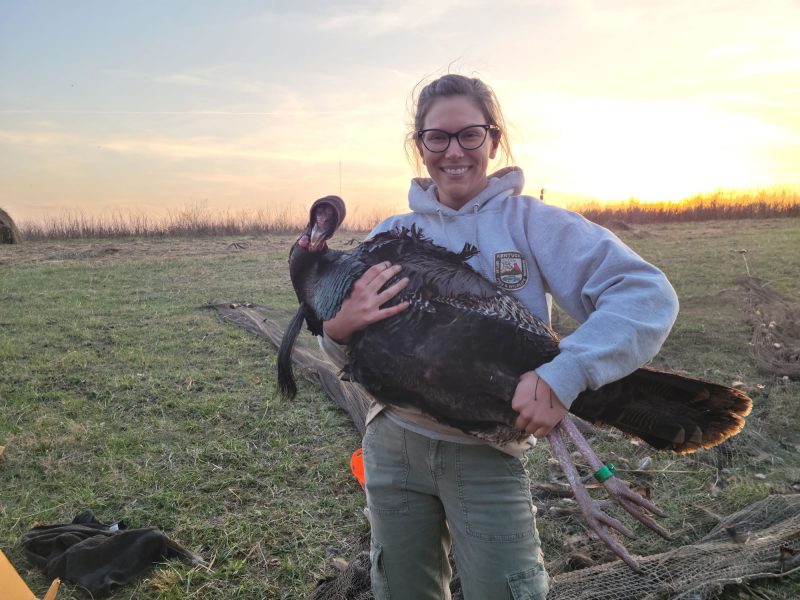Protect the Flock
Wild Turkey Banding in Kentucky
Across Kentucky’s fields and forests, biologists and volunteers have spent the past three years capturing and banding wild turkeys to answer big questions: How healthy are our flocks? How many birds are hunters really taking each spring? And what’s driving the ups and downs of turkey reproduction?
With populations declining in parts of the Southeast and hunters raising alarms about fewer gobbles in the woods, Kentucky’s wildlife managers launched one of the most ambitious turkey research efforts in the state’s history and teamed up with The Guardian to help tell this story.
The work is revealing new insights about harvest pressure, flock health, and the hidden lives of these iconic game birds — insights that could shape the future of turkey management and hunting traditions for years to come.
Wild Turkey Research in Kentucky:
Getting a Grip on Current Harvest Rates, Population Health, and Reproductive Ecology
Zak Danks, Wild Turkey Program Coordinator
Joe Lacefield, Bluegrass Regional Wildlife Biologist
Kentucky Department of Fish and Wildlife Resources
May 22, 2025
Wildlife management agencies adjust hunting regulations to change hunter harvest rates, either to curb population growth of an overabundant species or give struggling species a boost. To make the best possible management decision, state wildlife agencies need information from scientific studies of hunting pressure, disease risk, and reproductive success for the game populations they manage. Recent declines in wild turkey populations across the Southeast have raised concerns among hunters, prompting several states to enact more restrictive spring hunting regulations. In Kentucky over the past decade, hunter complaints about lower turkey numbers had increased, yet wildlife managers lacked current information needed to make informed management decisions.
Between January 2022 and March 2025, wildlife biologists with the Kentucky Department of Fish and Wildlife Resources (KDFWR) and Tennessee Technological University (TTU), with the help of dozens of volunteers and cooperative landowners, have captured and leg-banded between 260 and 535 wild turkeys per year on public and private lands across the state –a grand total of over 1,800 turkeys researched. These turkey captures constitute a multi-pronged research approach with the following goals: (1) to quantify male turkey harvest rates, or hunting pressure; (2) to assess the health of the flock, including rates of diseases like lymphoproliferative disease, blackhead disease, and avian influenza; and (3) to better understand the reproductive ecology of turkeys – behaviors and movements during critical breeding, nesting, brood-rearing periods, and the resulting measures of “the hatch” that influence population growth.
Statewide banding efforts have primarily targeted gobblers and jakes, which are the target of Kentucky hunters. In total, 1,274 males and 363 females have been leg-banded to date, with work planned to continue into 2026 and beyond as part of continued monitoring. In addition, 231 turkeys in western Kentucky have been fitted with GPS tracking transmitters for a finer-scale study of turkey movements, behaviors, and reproductive output. Over 600 blood samples have been collected from a subset of turkeys for the population health assessment and to conduct genetic analysis. KDFWR is partnering with researchers from TTU and the University of Georgia to analyze the resulting data. Disease testing results are eagerly awaited but still undergoing analysis. However, data from the banding and transmittering work is beginning to amass.

TTU master’s student Abigail Riggs, under the guidance of professor Bradley Cohen, PhD, has conducted an in-depth analysis of the first 3 years banding data for her thesis. She has found that, on average across regions in Kentucky, hunters harvest about 30% of the gobblers and 6% of the jakes annually. She estimated gobbler and jake survival at 56% and 78%, respectively. These rates are consistent with recent findings in other southern states, even those with differing turkey hunting regulations, including most notably in Tennessee, where Tennessee Wildlife Resource Agency staff have been banding gobblers concurrent with Kentucky’s efforts. Her results suggest that reducing bag limits may more effectively control harvest rates than changes to season length, such as in areas or times of consistently poor productivity, when a 1-bird bag limit may be necessary for population stability.
Similarly, TTU doctoral candidate Sara Watkins has been busy capturing, GPS-tagging, and tracking over 100 turkeys in the third and final season of fieldwork (of 231 total turkeys) towards her dissertation, also under the guidance of Dr. Cohen. As of March 2025, her turkeys have logged over 1.2 million GPS locations. Among preliminary findings, Sara has shown that reproductive success can vary dramatically between years; for instance, nest success improved from around 28% in 2023 to about 42% in 2024, and brood success improved from 40% to 54%. After her 2025 fieldwork and subsequent analyses are complete, this valuable data will help Sara paint a detailed picture of where, when, and how turkeys use the landscape; home range sizes of hens, jennies, jakes, and gobblers in different seasons; the timing and success of nesting and hatching, among many other parameters of interest.
In summary, KDFWR is gathering various forms of information on turkeys to make the best possible management decisions, the ultimate goal being to provide the highest quality hunting experience sustained in perpetuity. We appreciate the WTA Guardian Fund shedding light on the hard work and dedication of many individuals to bring science to bear in preserving our hunting heritage.
